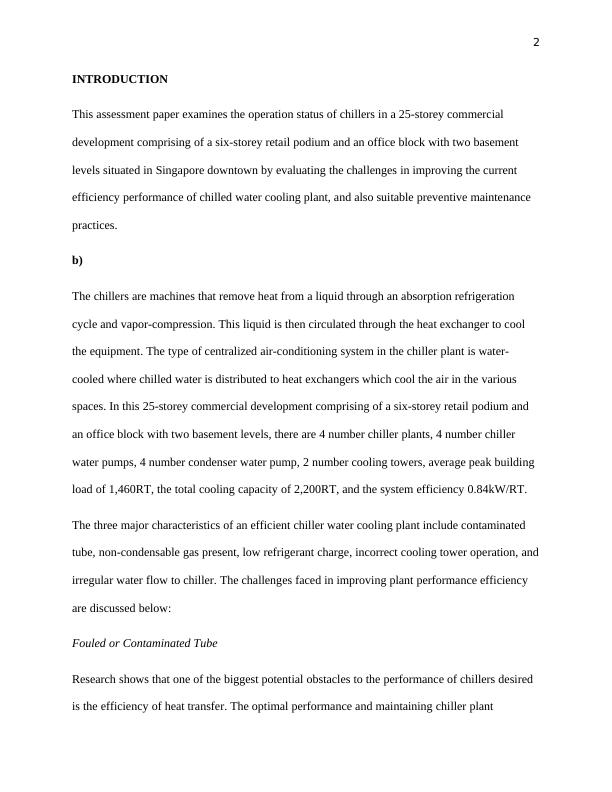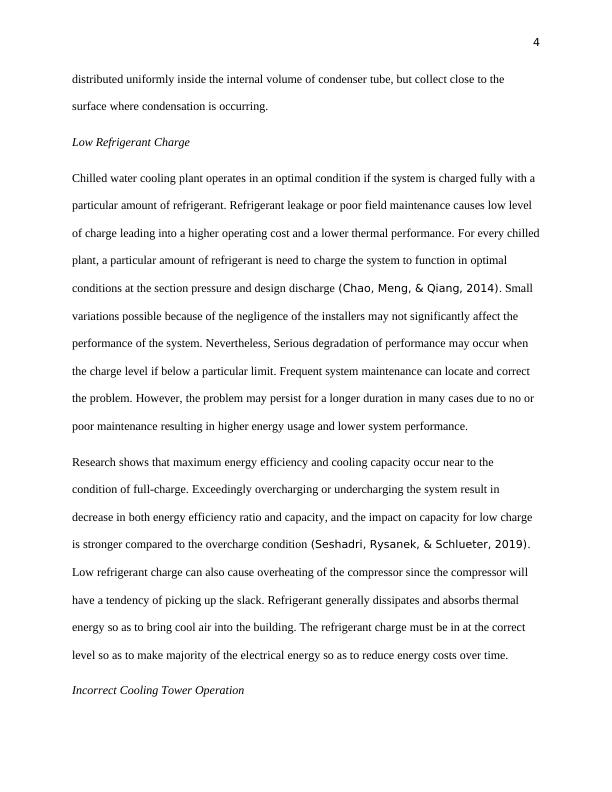Operation and Maintenance of Building Services Docx.
This is the end-of-course assessment for the FMT302 course on Operation and Maintenance of Building Services at Singapore University of Social Sciences. The assessment carries 70% of the course marks and must be done individually. The submission deadline is 18 March 2020.
12 Pages3071 Words27 Views
Added on 2022-08-23
Operation and Maintenance of Building Services Docx.
This is the end-of-course assessment for the FMT302 course on Operation and Maintenance of Building Services at Singapore University of Social Sciences. The assessment carries 70% of the course marks and must be done individually. The submission deadline is 18 March 2020.
Added on 2022-08-23
ShareRelated Documents
Running Head: OPERATION AND MAINTENANCE OF BUILDING
SERVICES
Operation and Maintenance of Building Services
Name
Institutional affiliation
SERVICES
Operation and Maintenance of Building Services
Name
Institutional affiliation

2
INTRODUCTION
This assessment paper examines the operation status of chillers in a 25-storey commercial
development comprising of a six-storey retail podium and an office block with two basement
levels situated in Singapore downtown by evaluating the challenges in improving the current
efficiency performance of chilled water cooling plant, and also suitable preventive maintenance
practices.
b)
The chillers are machines that remove heat from a liquid through an absorption refrigeration
cycle and vapor-compression. This liquid is then circulated through the heat exchanger to cool
the equipment. The type of centralized air-conditioning system in the chiller plant is water-
cooled where chilled water is distributed to heat exchangers which cool the air in the various
spaces. In this 25-storey commercial development comprising of a six-storey retail podium and
an office block with two basement levels, there are 4 number chiller plants, 4 number chiller
water pumps, 4 number condenser water pump, 2 number cooling towers, average peak building
load of 1,460RT, the total cooling capacity of 2,200RT, and the system efficiency 0.84kW/RT.
The three major characteristics of an efficient chiller water cooling plant include contaminated
tube, non-condensable gas present, low refrigerant charge, incorrect cooling tower operation, and
irregular water flow to chiller. The challenges faced in improving plant performance efficiency
are discussed below:
Fouled or Contaminated Tube
Research shows that one of the biggest potential obstacles to the performance of chillers desired
is the efficiency of heat transfer. The optimal performance and maintaining chiller plant
INTRODUCTION
This assessment paper examines the operation status of chillers in a 25-storey commercial
development comprising of a six-storey retail podium and an office block with two basement
levels situated in Singapore downtown by evaluating the challenges in improving the current
efficiency performance of chilled water cooling plant, and also suitable preventive maintenance
practices.
b)
The chillers are machines that remove heat from a liquid through an absorption refrigeration
cycle and vapor-compression. This liquid is then circulated through the heat exchanger to cool
the equipment. The type of centralized air-conditioning system in the chiller plant is water-
cooled where chilled water is distributed to heat exchangers which cool the air in the various
spaces. In this 25-storey commercial development comprising of a six-storey retail podium and
an office block with two basement levels, there are 4 number chiller plants, 4 number chiller
water pumps, 4 number condenser water pump, 2 number cooling towers, average peak building
load of 1,460RT, the total cooling capacity of 2,200RT, and the system efficiency 0.84kW/RT.
The three major characteristics of an efficient chiller water cooling plant include contaminated
tube, non-condensable gas present, low refrigerant charge, incorrect cooling tower operation, and
irregular water flow to chiller. The challenges faced in improving plant performance efficiency
are discussed below:
Fouled or Contaminated Tube
Research shows that one of the biggest potential obstacles to the performance of chillers desired
is the efficiency of heat transfer. The optimal performance and maintaining chiller plant

3
efficiency are directly related to the ability of the chiller to transfer heat and this starts with
having a clean condenser tubes and clean evaporator. The efficiency of the chiller water cooling
plant deteriorates as tubes become contaminated or fouled especially when contaminants, scale,
sludge, algae, or mud accumulate on the waterside surface of the heat-transfer surfaces (Zheng,
Watt, & Wang, 2016). The rate of system contamination depends on the type of the system
which can either be closed or open and also the water temperature, cleanliness, and quality. If the
tubes of the chiller become plugged or coated with biological growth, sludge, or scale, the ability
to transfer heat significantly drop.
All chiller makeup and circulating water contains contaminants. Chemical treatment of water
assist in preventing the accumulation of contaminants on the surfaces of heat transfer. The wrong
concentration or chemicals that are too high can damage the internal components. It is still
important to perform a cleaning of condenser tubes of the chiller water cooling plant using brush
even with suitable water treatment program (Thangavelu, Myat, & Khambadkone, 2017).
The annual cleaning can eliminate accumulation of loose materials, biological growth, and
sludge.
Presence of Non-condensable Gas
The presence of non-condensable gas in the condenser tubes of the chiller water cooling plant
introduces additional thermal resistance at the condenser which can substantially lower the
energy efficiency of the plant. The addition of thermal resistance caused by presence of non-
condensable gas in the condenser tube arises, deriving from a diffusion process of vapor in the
non-condensable gas layer that tends to concentrate near the condensing surface, being conveyed
by the centripetal force of vapor towards the tubes (Xiupeng, Guanglin, & Kusiak, 2014). It
is clear that a small quantity of non-condensable gas causes huge damage since they are not
efficiency are directly related to the ability of the chiller to transfer heat and this starts with
having a clean condenser tubes and clean evaporator. The efficiency of the chiller water cooling
plant deteriorates as tubes become contaminated or fouled especially when contaminants, scale,
sludge, algae, or mud accumulate on the waterside surface of the heat-transfer surfaces (Zheng,
Watt, & Wang, 2016). The rate of system contamination depends on the type of the system
which can either be closed or open and also the water temperature, cleanliness, and quality. If the
tubes of the chiller become plugged or coated with biological growth, sludge, or scale, the ability
to transfer heat significantly drop.
All chiller makeup and circulating water contains contaminants. Chemical treatment of water
assist in preventing the accumulation of contaminants on the surfaces of heat transfer. The wrong
concentration or chemicals that are too high can damage the internal components. It is still
important to perform a cleaning of condenser tubes of the chiller water cooling plant using brush
even with suitable water treatment program (Thangavelu, Myat, & Khambadkone, 2017).
The annual cleaning can eliminate accumulation of loose materials, biological growth, and
sludge.
Presence of Non-condensable Gas
The presence of non-condensable gas in the condenser tubes of the chiller water cooling plant
introduces additional thermal resistance at the condenser which can substantially lower the
energy efficiency of the plant. The addition of thermal resistance caused by presence of non-
condensable gas in the condenser tube arises, deriving from a diffusion process of vapor in the
non-condensable gas layer that tends to concentrate near the condensing surface, being conveyed
by the centripetal force of vapor towards the tubes (Xiupeng, Guanglin, & Kusiak, 2014). It
is clear that a small quantity of non-condensable gas causes huge damage since they are not

4
distributed uniformly inside the internal volume of condenser tube, but collect close to the
surface where condensation is occurring.
Low Refrigerant Charge
Chilled water cooling plant operates in an optimal condition if the system is charged fully with a
particular amount of refrigerant. Refrigerant leakage or poor field maintenance causes low level
of charge leading into a higher operating cost and a lower thermal performance. For every chilled
plant, a particular amount of refrigerant is need to charge the system to function in optimal
conditions at the section pressure and design discharge (Chao, Meng, & Qiang, 2014). Small
variations possible because of the negligence of the installers may not significantly affect the
performance of the system. Nevertheless, Serious degradation of performance may occur when
the charge level if below a particular limit. Frequent system maintenance can locate and correct
the problem. However, the problem may persist for a longer duration in many cases due to no or
poor maintenance resulting in higher energy usage and lower system performance.
Research shows that maximum energy efficiency and cooling capacity occur near to the
condition of full-charge. Exceedingly overcharging or undercharging the system result in
decrease in both energy efficiency ratio and capacity, and the impact on capacity for low charge
is stronger compared to the overcharge condition (Seshadri, Rysanek, & Schlueter, 2019).
Low refrigerant charge can also cause overheating of the compressor since the compressor will
have a tendency of picking up the slack. Refrigerant generally dissipates and absorbs thermal
energy so as to bring cool air into the building. The refrigerant charge must be in at the correct
level so as to make majority of the electrical energy so as to reduce energy costs over time.
Incorrect Cooling Tower Operation
distributed uniformly inside the internal volume of condenser tube, but collect close to the
surface where condensation is occurring.
Low Refrigerant Charge
Chilled water cooling plant operates in an optimal condition if the system is charged fully with a
particular amount of refrigerant. Refrigerant leakage or poor field maintenance causes low level
of charge leading into a higher operating cost and a lower thermal performance. For every chilled
plant, a particular amount of refrigerant is need to charge the system to function in optimal
conditions at the section pressure and design discharge (Chao, Meng, & Qiang, 2014). Small
variations possible because of the negligence of the installers may not significantly affect the
performance of the system. Nevertheless, Serious degradation of performance may occur when
the charge level if below a particular limit. Frequent system maintenance can locate and correct
the problem. However, the problem may persist for a longer duration in many cases due to no or
poor maintenance resulting in higher energy usage and lower system performance.
Research shows that maximum energy efficiency and cooling capacity occur near to the
condition of full-charge. Exceedingly overcharging or undercharging the system result in
decrease in both energy efficiency ratio and capacity, and the impact on capacity for low charge
is stronger compared to the overcharge condition (Seshadri, Rysanek, & Schlueter, 2019).
Low refrigerant charge can also cause overheating of the compressor since the compressor will
have a tendency of picking up the slack. Refrigerant generally dissipates and absorbs thermal
energy so as to bring cool air into the building. The refrigerant charge must be in at the correct
level so as to make majority of the electrical energy so as to reduce energy costs over time.
Incorrect Cooling Tower Operation

End of preview
Want to access all the pages? Upload your documents or become a member.
Related Documents
Plantlg...
|4
|543
|233
